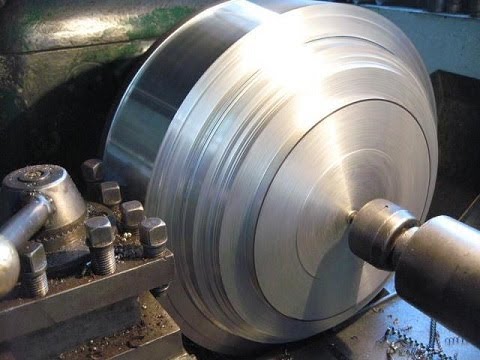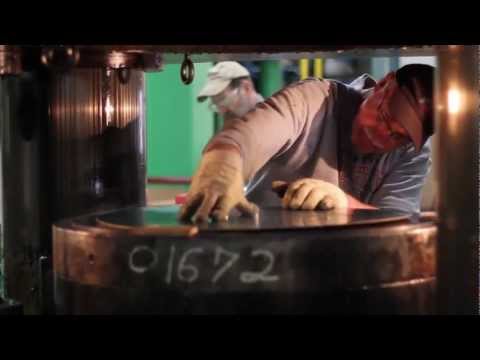True to Form: The Value of Metal Spinning and Hydroforming
Looking to produce for minimal scrap in rounded or irregularly shaped parts? Metal spinning and hydroforming may be for you.
Looking to produce for minimal scrap in rounded or irregularly shaped parts? Metal spinning and hydroforming may be for you.
Are your part quantities too low for a forming die? Do you only need a prototype? Here are two alternatives to stamping and deep draw stamping that are worthy of attention: metal spinning and hydroforming.
Parts shaped like top hats, mixing bowls and rocket nose cones are easy enough to make, but producing large quantities of them typically means investing in a forming die. This can add significant costs to a project that might need only a handful of parts—and weeks or months to the delivery lead time.
The good news is that there are options: Hydroforming and metal spinning are mature, predictable machining processes, though they are generally not well understood.
Both metalworking approaches are able to compete on lower-volume work that would otherwise require dedicated tooling and deliver parts that might otherwise be impractical to produce. Here’s what you need to know about metal spinning and hydroforming.
For those machinists who quote on parts that resemble bowls and top hats and wonder how those parts are made, this is for you. Metal spinning works by gently forcing metal sheets over a mandrel machined to the same shape and size as the interior of the desired workpiece.
It is usually a “cold” process helping it to flow into tight areas and around corners or where work hardening is a concern. Take note: A blowtorch might be used to make the metal more malleable.
Any ductile metal is suitable for metal spinning, including aluminum, copper, brass, carbon and stainless steels, and superalloys, such as titanium and Inconel.
If you wish to make a stainless-steel bell, for example, you would first mount a bell-shaped mandrel onto a lathe spindle. The mandrel can be made of wood, hard plastic or metal for higher-volume work.
A disc slightly larger than the maximum length of the bell’s outer surface is needed and is fairly thin—roughly 1/8 of an inch, but it depends on the size of the bell. Some specialty shops suggest that materials up to 1 inch or thicker can be spun.

The disc is then positioned at the end of the mandrel and pinched against it with a rotating pressure pad similar to a tailstock-mounted live center. Once the lathe spindle is engaged, a tool appropriately called a “spoon” is used to apply pressure, gradually forcing the metal into the desired shape.
It is often a manual process. Craftspeople have been spinning metal parts for as long as there have been lathes and strong-arms. However, CNC spinning machines are also available that offer greater accuracy and productivity. In this instance, a roller-style tool would be used.
There is very little waste with metal spinning.
In the bell example, the only scrap would be a narrow ring around the bell’s base that is trimmed away after forming. Uniform wall thicknesses with accuracies to +/-0.015” are possible with CNC, as are mirror finishes, assuming a burnishing-style spoon or roller tool is applied. If not, some tool marks may be visible.
Do you need a technical question answered? Ask the MSC Metalworking Tech Team in the forum.
Hydroforming shares a few similarities with metal spinning, but the displacement mechanism is quite different. For instance, a blank slightly larger than the finished workpiece is used as the starting point.
It does not need to be round—hydroforming can produce polygons and irregularly shaped workpieces, provided the corners are rounded. A wide variety of ductile metals can be formed, similar to metal spinning; however, hydroforming does favor thinner gage materials and more complex part geometries.
There’s a mandrel involved, but it doesn’t spin and there’s no need for a spoon or roller tool. Instead, the mandrel is placed on the bed of a machine that looks much like any other forming press. In this instance, think of the mandrel as a male punch.
Take note: You can use multiple mandrels at once, including those with different shapes. The difference is the presence of an elastomeric bladder that acts like a die.

There are various hydroforming techniques including fluid cell hydroforming, tube hydroforming, deep draw hydroforming and others. All rely on hydraulic pressure, but some allow the use of female mandrels as they do in metal spinning. Other types use a mechanism to grip the material edges to prevent wrinkling, and some move the mandrel rather than the bladder.
To illustrate hydroforming in action, let’s look at fluid cell hydroforming.
Once the workpiece blank has been positioned over the mandrels, the ram drops into place, enclosing the workspace, and thousands of pounds of hydraulic pressure are applied. This forces the bladder against the material and forms itself to the male forms below.
Think of it like a deep-drawing process. It may be an oversimplification, but it is a complex process—and it may involve many more steps depending on the hydroforming technique used.
Need more axes to produce more parts? Learn how. Read “Is It Time to Embrace High-Performance Machining?”
Metal spinning and hydroforming are excellent alternatives to traditional deep drawing because tooling investment is a smaller fraction of traditional forming processes. Setup times are shorter, too, and flexibility is increased.
These technologies can also be competitive in higher-volume scenarios—especially in hydroforming. It is widely used in the aerospace and automotive industries for a range of complex, production-level components.
What drawbacks or advantages do you find in deep draw stamping? Have you evaluated spinning or hydroforming? Talk to your peers in the metalworking forum. [registration required]
Hydroforming and metal spinning have tremendous potential, but have you ever wondered how beer and soda cans are made? How about scuba tanks, stainless-steel sinks and metal battery housings? Though simple in appearance, these products represent one of the most complex of all metalworking technologies: deep draw stamping.
Deep draw stamping is loosely defined as any forming operation that produces parts at least twice as high as they are wide. Like hydroforming and metal spinning, it requires a mandrel—in stamping parlance, a punch—over which the material is formed, and a flat blank as a starting point.
What’s different is that a die is also required. This die is a female mirror of the punch.
The process generally can’t be completed in one shot. Multiple “draws” are needed to bring the product to its final form, each one stretching the metal a bit more without breaking it, and it includes a last-step trimming.
Despite these additional steps, deep draw stamping can be quite fast. According to the Can Manufacturers Institute, soda cans require no less than 11 distinct manufacturing operations but are cranked out at the rate of “hundreds per minute.”
Think about that the next time you crack open a cold beverage.




